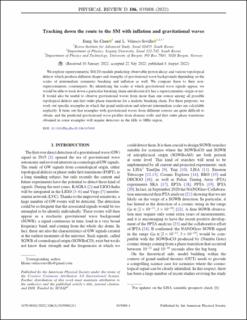Tracking down the route to the SM with inflation and gravitational waves
Journal article, Peer reviewed
Published version

Åpne
Permanent lenke
https://hdl.handle.net/11250/3059025Utgivelsesdato
2022Metadata
Vis full innførselSamlinger
Sammendrag
We explore supersymmetric SO(10) models predicting observable proton decay and various topological defects which produce different shapes and strengths of gravitational wave backgrounds depending on the scales of intermediate symmetry breaking and inflation as well. We compare these to their nonsupersymmetric counterparts. By identifying the scales at which gravitational wave signals appear, we would be able to track down a particular breaking chain and discern if it has a supersymmetric origin or not. It would also be useful to observe gravitational waves from more than one source among all possible topological defects and first order phase transitions for a realistic breaking chain. For these purposes, we work out specific examples in which the grand unification and relevant intermediate scales are calculable explicitly. It turns out that examples with gravitational waves from different sources are quite difficult to obtain, and the predicted gravitational wave profiles from domain walls and first order phase transitions obtained in some examples will require detectors in the kHz to MHz region.
